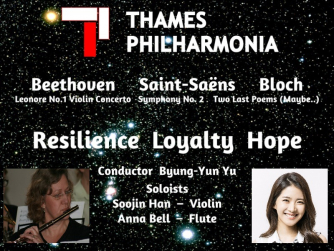Details
Landmark Arts Centre
Ferry road
Teddington
London
TW11 9NN
England
Programme
Ludwig van Beethoven – Violin Concerto in D major, Op.61
Ludwig van Beethoven – Leonore Overture no.1, Op.138
Ernest Bloch – Two Last Poems (Maybe...)
Camille Saint-Saens – Symphony no.2, Op.55
Performers
Soojin Han – violin
Anna Bell – flute
Thames Philharmonia
Programme Note
Beethoven is the cornerstone of this celebration of resilience, loyalty and hope; a story told in each of these compositions spanning 150 years. Both Saints-Saëns and Bloch were students of his compositional genius and innovation and keen performers of his work at the piano and on the podium.
Soojin Han is the soloist for Beethoven’s violin concerto (1806) which only gained acceptance following a London tour by Joseph Joachim (age 12) conducted by Mendelssohn in 1844 and this sublime and ultimately cheerful work has been popular ever since. “Soojin is a wonderful violinist with extraordinary subtlety and great expressiveness...and remarkable instrumental mastery” - Gidon Kremer.
Beethoven composed four overtures to the various versions of the opera Fidelio, the Leonore Overture No. 1, was the third, written for a tour of the opera to Prague that was cancelled and was anecdotally preferred by the composer even though superseded by the lighter “Fidelio Overture” in future performances as an introduction to an opera thought to be more ‘suitable’. All Leonore overtures demonstrate the attempt to capture in compressed form the action on stage in sound, resulting in an impressive concentration of motives and harmonic developments.
The programme features a poignant and evocative piece by Ernest Bloch, with the tentatively valedictory title “Two Last Poems (Maybe...)” for solo flute and orchestra (1958). The soloist is Anna Bell, the orchestra’s principal flautist. Albert Einstein, the first President of the Bloch Society wrote “I esteem the works of Ernest Bloch above those of any other contemporary composer known to me”.
Saint-Saëns, a composer of the mid 19th/early 20th century supported the most modern music of the time (Liszt, Schumann, Wagner) but retained a distinctive voice of his own and withstood pressure from critics of the day preferring to draw upon his classical background. His short 2nd Symphony is a fine example of orchestral economy and structural cohesion showing his skill in fugal writing with the Gallic charm of Rameau.

 Your events at Classical Events
Your events at Classical Events

